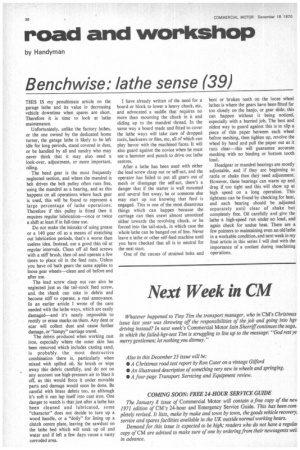road and workshop
Page 40

If you've noticed an error in this article please click here to report it so we can fix it.
by Handyman
Benchwise: lathe sense (39)
THIS IS my penultimate article on the garage lathe and its value in decreasing vehicle downtime when spares are short. Therefore it is time to look at lathe maintenance.
Unfortunately, unlike the factory lathes, or the one owned by the dedicated home turner, the garage lathe is likely to be left idle for long periods, stand covered in dust, or be handled by all and sundry who may never think that it may also need a look-over, adjustment, or more important, oiling.
• The head gear is the most frequently neglected section, and where the mandrel is belt driven the belt pulley often runs free, using the mandrel as a bearing, and as this happens on all operations where back gear is used, this will be found to represent a large percentage of lathe operations. Therefore if this pulley is fitted then it requires regular lubrication—once or twice a shift at least if in full-time use.
Do not make themistake of using grease or a 140 gear oil as a means of stretching out lubrication periods, that's a worse than useless idea. Instead, use a good thin oil at regular intervals. Clean off all feed screws with a stiff brush, then oil and operate a few times to place oil in the feed nuts. Unless you have oil bath gears the same applies to loose gear wheels—clean and oil before and after use.
The lead screw clasp nut can also be neglected just as the tail-stock feed screw, and, the shank can take in debris and become stiff to operate, a real annoyance. In an earlier article I wrote of the care needed with the lathe ways, which are easily damaged—and it's nearly impossible to rectify or erase marks on them. Any dent or scar will collect dust and cause further damage, or "lumpy" carriage travel.
The debris produced when working cast iron, especially where the outer skin has been removed which includes casting sand, is probably the most destructive combination there is, particularly when mixed with spilled oil. So brush or wipe away this debris carefully, and do not on any account use high-pressure air to blast it off, as this would force it under movable parts and damage would soon be done. Be careful with brass debris too, as although it's soft it can lap itself into cast iron. One danger to watch is that just after a lathe has been cleaned and lubricated, some "character" does not decide to turn up a wood handle, or a "dolly" for lining up a clutch centre plate, leaving the sawdust on the lathe bed which will soak up oil and water and if left a few days cause a nasty corroded area. I have already written of the need for a board or block to lower a heavy chuck, etc, and advocated a saddle that requires no more than mounting the chuck in it and sliding up to the mandrel thread. In the same way a board made and fitted to cover the lathe ways will take care of' dropped tools, hacksaws or files, etc, all of which can play havoc with the machined faces. It will also guard against the novice when he must use a hammer and punch to drive out lathe centres.
After a lathe has been used with either the lead screw clasp nut or self-act, and the operator has failed to put all gears out of mesh or disengage the self-act, there's a danger that if the starter is wall mounted and several feet away, he or someone else may start up not knowing that feed is engaged. This is one of the most disastrous things which can happen because the carriage can then crawl almost unnoticed either towards the revolving chuck, or be forced into the tail-stock, in which case the whole lathe can be banged out of line. Never leave a lathe or other self-feed machine until you have checked that all is in neutral for the next start.
One of the causes of strained bolts and bent or broken teeth on the loose wheel lathes is where the gears have been fitted far too closely on the banjo, or gear slide; this can happen without it • being noticed, especially with a hurried job. The best and oldest way to guard against this is to slip a piece of thin paper between each wheel before meshing, then tighten up, revolve the wheel by hand and pull the paper out as it runs clear—this will guarantee accurate meshing with no binding or bottom tooth load.
Headgear or mandrel bearings are mostly adjustable, and if they are beginning to rattle or shake then the' need adjustment. However, these bearings can warm up and drag if too tight and this will show up at high speed on a long operation. This tightness can be found by checking for heat, and each bearing should be adjusted separately until clear of shake but completely free. Oil carefully and give the lathe a high-speed run under no load, and again check for undue heat. There are a few pointers to maintaining even an old lathe in a workable condition, and next week in my final article in this series I will deal with the importance of a coolant during machining operations.






















































































































